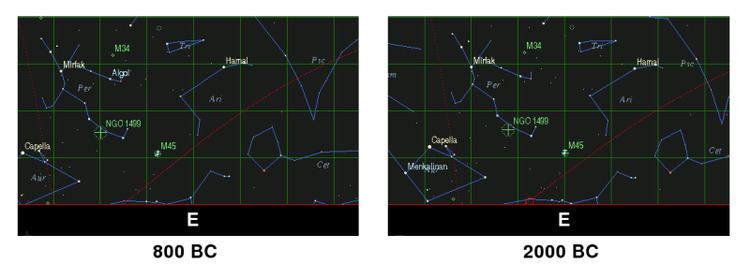 | ||
The history of Indian astronomy begins with the Vedic period, Lagadha and composition of Vedanga Jyotisha (1400 BCE - 1200 BCE). Astronomical knowledge in India reached an early peak in the 5th century CE, with the Āryabhaṭīya. Its author, Aryabhata, uses astronomical calculations to determine the date of the Battle of Kurukshetra as 18 February 3102 BCE. This date has become traditional and is still widely cited in Hindu literature.
Contents
Modern authors attempted to date the Vedic period based on archaeoastronomical calculations. Thus, William Jones who tried to show, based on information gathered from Varaha Mihira, that Parashara muni lived at 1181 BCE. Hermann Jacobi has argued that in the Rigveda and Atharvaveda the sun was in Phalguni, and in the Sankhayana and Gobhila Grhyasutra the Full moon was in Bhadrapada during the summer solstice, which would have occurred at 4500-2500 BCE.
Jacobi and Tilak have both noted that the terms of the naksatras Mula (root), Vicrtau (dividers) and Jyestha (oldest) suggest that these names originated from a time when Mula marked the beginning of the year, i.e. about 4500-2500 BCE. Tilak has also noted that the two week long pitrs period after the full moon in Bhadrapada occurred at the beginning of the pitryana, which would have been true at about 4500-2500 BCE.
Samhitas
In RV 5.40.5-9, a solar eclipse is referred to: Surya is obscured by an Asura called Svarbhanu ("self-luminous"), but recovered by the Atris.
"The One" referred to in the Nasadiya Sukta and other hymns has been suggested to have originally referred to the axis mundi, and "The One who dwells beyond the seven sages" as the polar star, at the time referring to Thuban (α Draconis).
The samvatsara "full year" in the Yajurveda has 360 days, and 12 (TS) or 13 (VS) months.
Brahmanas
The visuvant (summer solstice) period is 21 days in Aitreya Br. and 7 days in Pancavimsa Br., the summer solstice being in the middle of the period.
The gavam ayana ritual in SB 4.6.2. is based on the motion of the sun.
In the Maitrayana Brahmana Upanishad (6.14), the year is said to be into two portions, with the part from Magha to half of Śraviṣṭha associated with Agni, and the part from Sārpa to half of Śraviṣṭha associated with Varuna and Saumya (the moon). Aiyar has argued that Agni suggests the warm half and similarly Varuna the cool half of the year, suggesting the summer solstice at the beginning of Maghā and thus implying the vernal equinox in Kṛttikā. This, according to Kak, would correspond to 1660 BCE.
The Shatapatha Brahmana mentions that the Krttikas (the Pleiades) "do not swerve from the east". This would have been the case with precision at 2950 BCE and was true also about 2000 BCE, but was still true to within 8-13 degrees (viz., East by north) around the 8th to 6th centuries BCE, the assumed date of the text's composition.
Vedanga Jyotisa
The positions of the solstices and equinoxes in the Vedanga Jyotisha, with the sun very close to the Krittika at the Vernal Equinox., would correspond to about 1370 BCE, although the text in its present form is from a later date, around 700 - 600 BCE.
The Vedanga Jyotisha, in common with Mesopotamian texts, asserts a 3:2 ratio between the durations of daylight on the longest and shortest days of the year. This corresponds to a latitude of about 35 degrees. A latitude of 34 degrees would correspond to Northern India.
